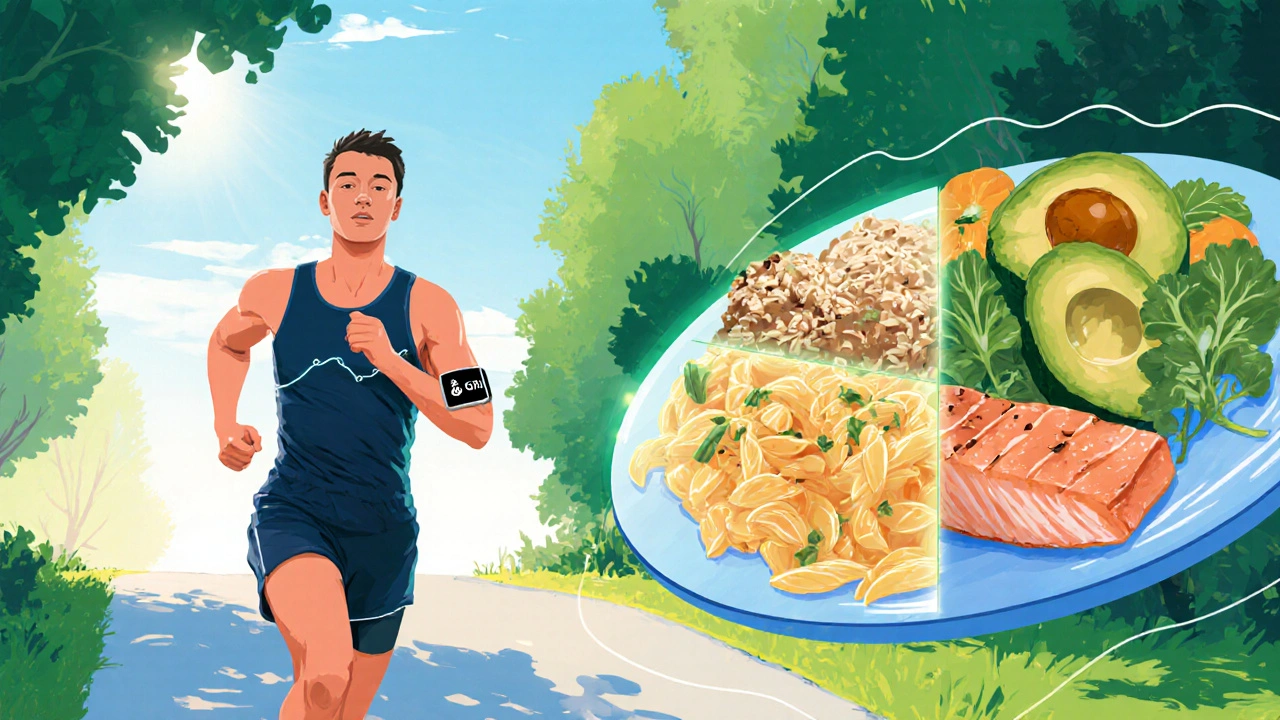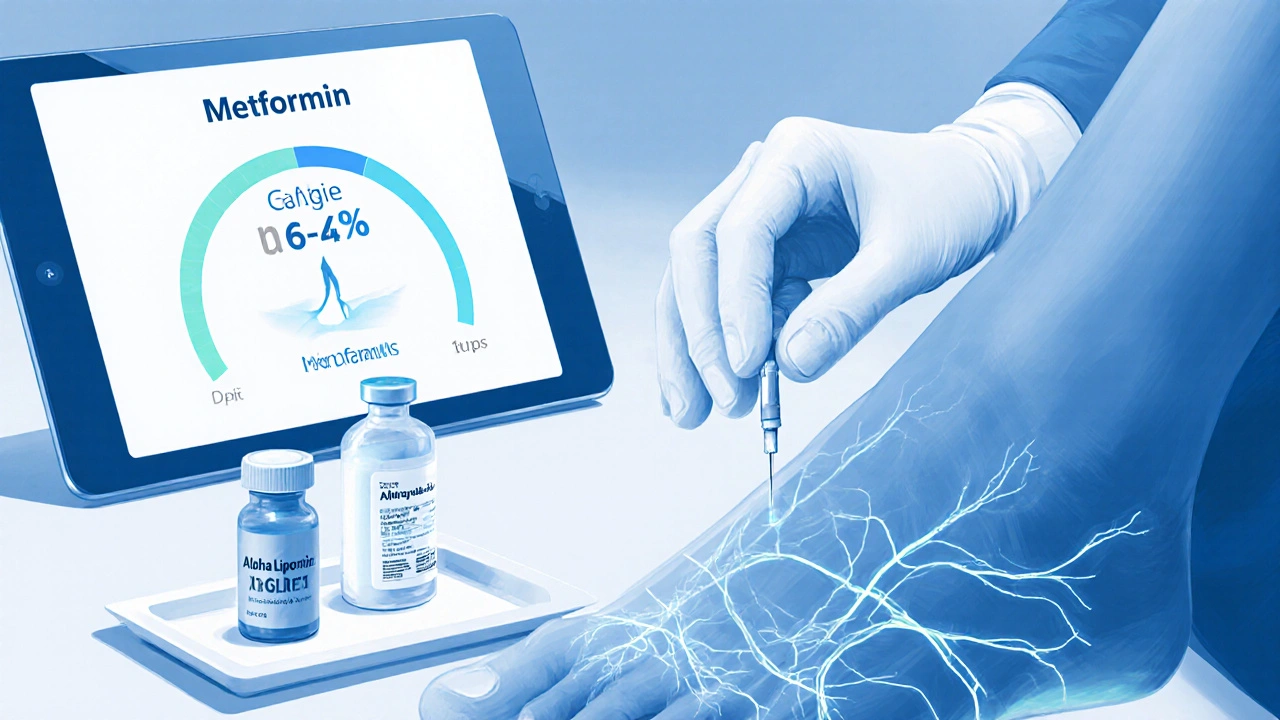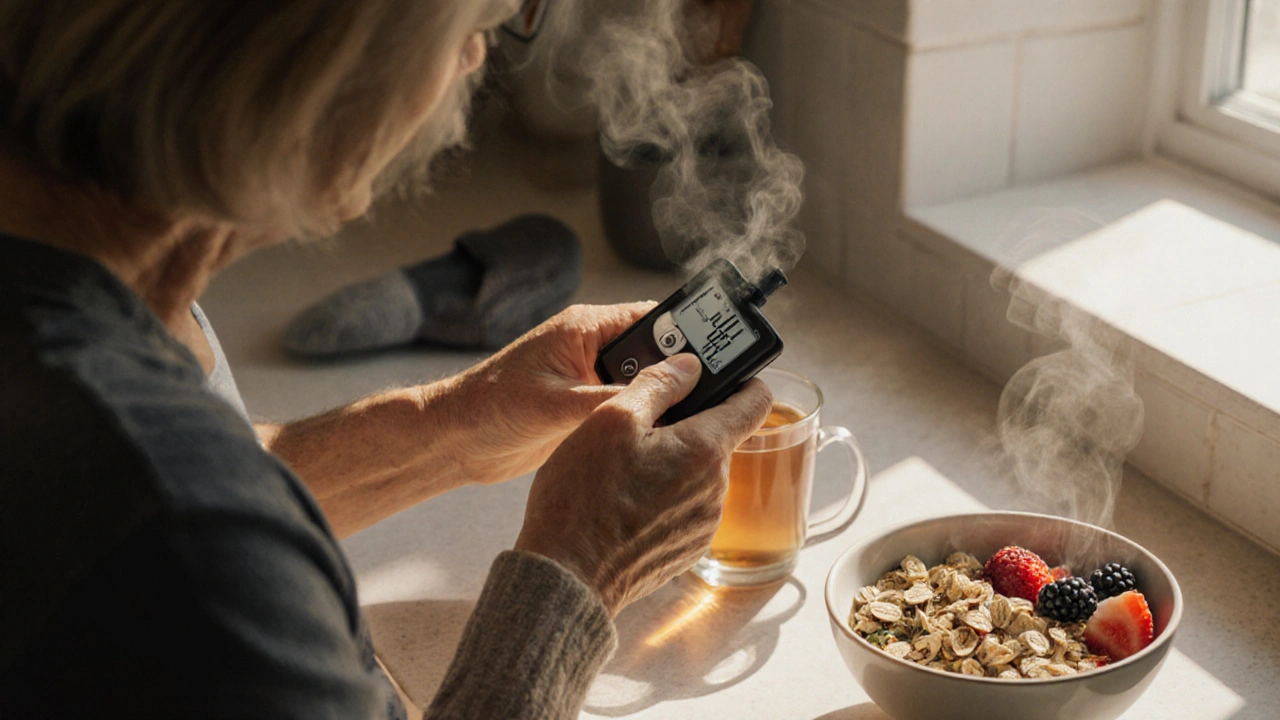Blood Sugar Target Calculator for Neuropathy Management
Your Recommended Target Range
Based on your inputs, your ideal HbA1c target range is:
Living with diabetes often means worrying about more than just glucose numbers. One of the toughest complications is nerve pain that starts in the feet or hands-known as diabetic peripheral neuropathy. The good news? Keeping your blood sugar steady can slow, halt, or even reverse some of that damage. This guide explains exactly how blood sugar control fits into neuropathy management and gives you real‑world steps to protect your nerves.
Quick Summary
- High glucose damages peripheral nerves through oxidative stress and inflammation.
- Targeting an HbA1c below 7% reduces the risk of new neuropathy by up to 30%.
- Consistent monitoring, balanced meals, regular movement, and proper foot care are the frontline defenses.
- Medication choices that stabilize glucose also lessen pain intensity.
- Regular check‑ups let you spot nerve changes early and adjust treatment before they worsen.
What Is Diabetic Peripheral Neuropathy?
When talking about nerve damage in diabetes, Diabetic Peripheral Neuropathy is a condition where high blood glucose harms the peripheral nerves, leading to pain, tingling, or loss of sensation in the feet and hands. It usually develops slowly, often after a decade of uncontrolled diabetes, but the timeline can vary widely.
Why Blood Sugar Control Matters
Glucose isn’t just a number on a meter; it’s a chemical that can wreak havoc on tiny nerve fibers. Elevated blood sugar the concentration of glucose circulating in the bloodstream triggers oxidative stress, which damages the blood vessels that feed nerves. Over time, this leads to the classic numbness and burning sensations of neuropathy.
One of the best ways to gauge long‑term control is the glycated hemoglobin, or HbA1c a lab test that reflects average blood glucose over the past two to three months. Studies from the American Diabetes Association (ADA) show that each 1% drop in HbA1c can cut the incidence of new neuropathy cases by roughly 30%.
Setting Effective Blood Sugar Targets for Nerve Health
General diabetes guidelines aim for an HbA1c under 7%, but when neuropathy is present, tighter control often brings more relief. Below is a quick comparison of target ranges recommended for people with and without nerve complications.
| Patient Group | Recommended HbA1c | Rationale |
|---|---|---|
| General diabetes | < 7% | Reduces risk of macro‑ and micro‑vascular complications |
| Diabetic peripheral neuropathy | 6-6.5% | Lower glucose spikes help protect nerve fibers and lessen pain |
| Older adults or high‑risk hypoglycemia | 7.5-8% | Balances safety with benefit when tight control is unsafe |

Practical Ways to Keep Blood Sugar in Check
Achieving a 6-6.5% HbA1c isn’t magic; it’s a mix of daily habits.
- Meal Planning: Focus on low‑glycemic carbs (whole grains, legumes) paired with protein and healthy fats. dietary management choosing foods that stabilize glucose levels prevents post‑meal spikes that stress nerves.
- Regular Physical Activity: Aim for 150minutes of moderate aerobic exercise weekly-walking, cycling, swimming. exercise muscle activity that improves insulin sensitivity helps cells absorb glucose without extra insulin.
- Medication Adherence: Take prescribed drugs exactly as directed. insulin therapy injectable insulin that lowers blood glucose or oral agents like metformin first‑line oral drug that reduces hepatic glucose production are essential for many patients.
- Self‑Monitoring: Use a glucometer or continuous glucose monitor (CGM) to record trends. Spotting a pattern-like high readings after dinner-lets you tweak meals or medication promptly.
- Stress Management: Cortisol spikes raise glucose. Simple practices such as deep breathing, meditation, or short walks can keep stress‑related glucose hikes at bay.
Medications That Influence Neuropathy Outcomes
Beyond glucose‑lowering drugs, a few medications have dual benefits for nerve health.
- GLP‑1 Receptor Agonists (e.g., liraglutide) improve insulin response and have been linked to reduced inflammatory markers in nerve tissue.
- SGLT2 Inhibitors (e.g., empagliflozin) lower glucose by increasing urinary excretion and may protect micro‑vascular supply to nerves.
- Alpha‑Lipoic Acid is an antioxidant supplement that some trials show can lessen neuropathic pain when combined with tight glucose control.
Always discuss any add‑on therapy with your healthcare provider to avoid drug interactions.
Lifestyle Add‑Ons: Foot Care and Pain Management
Even with perfect glucose numbers, damaged nerves need extra attention.
- Daily Foot Inspection: Look for cuts, redness, or swelling. Early treatment prevents infections that can lead to ulcers.
- Proper Footwear: Cushioning shoes reduce pressure points that aggravate numbness.
- Topical Treatments: Capsaicin cream or lidocaine patches can numb localized pain.
- Prescription Pain Meds: For moderate‑to‑severe symptoms, doctors may use duloxetine or pregabalin, which target nerve pain pathways.
Monitoring Progress and When to Act
Effective management is a partnership between you and your care team.
- Quarterly HbA1c Checks: Review trends with your doctor. If you’re consistently above target, discuss medication adjustments.
- Neuropathy Screening: A simple monofilament test at each visit assesses sensation loss.
- Symptom Diary: Note pain intensity, time of day, and activities that help or worsen it. This data guides therapy tweaks.
- Prompt Referral: If you notice sudden numbness, loss of balance, or foot ulcers, seek care immediately to prevent complications.
Common Pitfalls and Pro Tips
Even motivated patients stumble. Here’s a quick checklist of what to avoid and what to embrace.
- Don’t chase perfection: Small glucose excursions are normal. Aim for consistency, not zero variance.
- Avoid skipping meals: Irregular eating leads to hypoglycemia, which can trigger rebound hyperglycemia-a double hit for nerves.
- Embrace technology: CGM alerts can warn you before glucose spikes become damaging.
- Stay educated: Guidelines evolve; an annual review of ADA recommendations keeps your plan up‑to‑date.

Frequently Asked Questions
Can tight blood sugar control reverse existing nerve damage?
Complete reversal is rare, but lowering glucose can halt progression and reduce pain. Many patients report measurable improvement in sensation after achieving target HbA1c levels for six months or more.
How often should I test my blood sugar if I have neuropathy?
At least four times a day-fasting, pre‑meal, post‑meal, and bedtime-helps you catch patterns that affect nerve health. CGM users can rely on trend alerts instead of manual fingersticks.
Is there a specific HbA1c number I should aim for?
For most adults with diabetic peripheral neuropathy, an HbA1c between 6% and 6.5% is optimal. Individual targets may vary based on age, comorbidities, and risk of hypoglycemia.
What role does diet play beyond glucose control?
A diet rich in omega‑3 fatty acids, antioxidants (berries, leafy greens), and fiber reduces inflammation, which is a key driver of nerve damage. Limiting processed sugars also prevents glucose spikes that stress nerves.
Should I take supplements for neuropathy?
Alpha‑lipoic acid, vitamin B12 (if deficient), and magnesium have modest evidence for pain relief. Always discuss supplement use with your clinician to avoid interactions.


Oh great, another calculator to tell me I’m doin it wrong :)
Hey folks, just wanted to add a splash of color to this chat. The guide is solid, but let’s not forget the human side-people from all walks need a friendly nudge. Remember, diet isn’t just numbers; it’s culture, family, and sometimes grandma’s secret recipes. If you can’t find a low‑glycemic grain, try swapping with quinoa or millet – they’re tasty and kind to nerves. Also, a quick tip: wear socks that aren’t too tight, especially after a long day, to keep blood flowing. Don’t overlook the power of a simple foot rub with moisturizer – it can actually reduce discomfort. Lastly, keep an eye on your shoes; a little wear‑and‑tear can become a big problem fast. Stay safe and keep sharing your wins, we’re all in this together.
Dear readers, let me commend the thoroughness of the article; it reflects diligent research and a commendable desire to aid patients. While the recommendations are sound, one must appreciate that each individual’s journey with neuropathy is distinct, necessitating personalized adjustments. The inclusion of GLP‑1 agonists and SGLT2 inhibitors is particularly noteworthy, albeit with the caveat of vigilant renal monitoring. Moreover, the emphasis on foot care cannot be overstated – a single ulcer may spiral into severe complications. In sum, adhere to the guidelines, but remain ever‑mindful of the nuanced reality of clinical practice.
While the enthusiasm for tight control is admirable, one must ask whether the relentless pursuit of numbers truly serves the soul. The body, after all, is a delicate equilibrium, not merely a spreadsheet of glucose percentages. A focus on metrics can obscure the lived experience of pain and fatigue that patients endure daily. Moreover, the prescription of adjunctive therapies without holistic consideration may lead to a cascade of side effects. Therefore, ponder the balance between data‑driven strategies and compassionate, individualized care.
Okay, listen up because I’m about to drop the ultimate guide on managing diabetic peripheral neuropathy and you’re going to thank me later. First off, the whole "target HbA1c 6‑6.5%" thing isn’t just a suggestion – it’s backed by a mountain of studies, so stop guessing and start aiming for that sweet spot. You think diet is just about cutting carbs? Wrong. You need to focus on the glycemic index, fiber content, and timing of meals – eat a balanced plate every 3‑4 hours to keep glucose stable. Second, exercise isn’t optional; it’s mandatory. Aim for at least 150 minutes of moderate cardio per week, and throw in resistance training twice a week to boost insulin sensitivity. Third, medication adherence – you can’t be half‑assing your meds. If you’re on metformin, take it with meals; if you’re on insulin, calibrate your doses using a reliable CGM, not guesswork. Fourth, the tech side – CGM devices aren’t just for the tech‑savvy; they’re lifesavers, alerting you to trends before your pancreas even knows what’s happening. Fifth, supplements – alpha‑lipoic acid, vitamin B12, and magnesium have real evidence; they can reduce pain and support nerve repair, but make sure your doctor clears them. Sixth, foot care – inspect daily, keep nails trimmed, and wear proper shoes; a tiny ulcer can turn into an amputation faster than you can say “oops”. Seventh, stress management – cortisol spikes are a real enemy, so incorporate meditation, deep breathing, or even a quick walk when you feel tension building. Eighth, keep a symptom diary – note pain levels, triggers, and what you ate; patterns emerge that your doctor will love. Ninth, regular check‑ups – quarterly HbA1c tests, monofilament exams, and nerve conduction studies when needed. Tenth, don’t ignore the warning signs: sudden numbness, loss of balance, or a foot that’s red and warm – get medical attention immediately. Finally, remember that perfection isn’t the goal, consistency is. Stick to the plan, adjust as needed, and you’ll keep those nerves as healthy as possible. Got all that? Good. Now go implement it.
Thank you for that detailed explanation, Blake. I truly appreciate the depth and the practical steps you’ve shared. It can feel overwhelming, but knowing there’s a clear path gives me hope. Please remember you’re not alone on this journey; we’re all here to support each other.